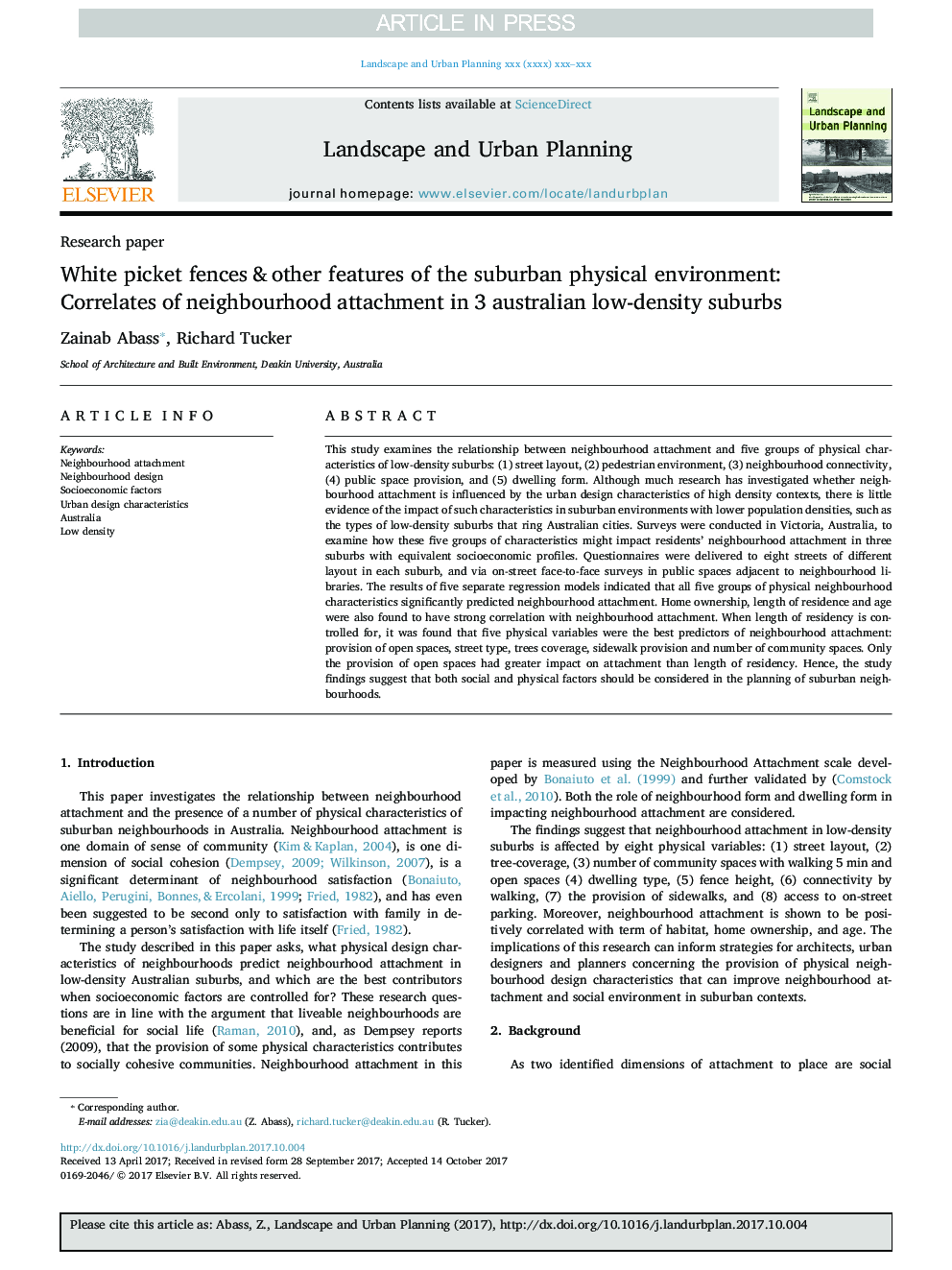| کد مقاله | کد نشریه | سال انتشار | مقاله انگلیسی | نسخه تمام متن |
|---|---|---|---|---|
| 7460092 | 1484588 | 2018 | 10 صفحه PDF | دانلود رایگان |
عنوان انگلیسی مقاله ISI
White picket fences & other features of the suburban physical environment: Correlates of neighbourhood attachment in 3 australian low-density suburbs
ترجمه فارسی عنوان
حصارهای سفالی سفید و سایر ویژگی های محیط فیزیکی حومه: همبستگی محله در 3 حومه کم جمعیت چینی استرالیا
دانلود مقاله + سفارش ترجمه
دانلود مقاله ISI انگلیسی
رایگان برای ایرانیان
کلمات کلیدی
دلبستگی محله طراحی محله، عوامل اجتماعی-اقتصادی، ویژگی های طراحی شهری، استرالیا، تراکم کم،
ترجمه چکیده
این مطالعه رابطه میان دلبستگی محله و پنج گروه از ویژگی های فیزیکی حومه های کم تراکمی را مورد بررسی قرار می دهد: (1) طرح خیابان، (2) محیط عابر پیاده، (3) اتصال محله، (4) ارائه فضای عمومی و (5) فرم. اگر چه تحقیقات زیادی انجام شده است که آیا وابستگی محله به دلیل ویژگی های طراحی شهری در زمینه های چگالی بالایی تحت تاثیر قرار گرفته است، شواهد کمی از تاثیر این خصوصیات در محیط های حومه با تراکم جمعیت پایین، مانند انواع حومه های کم تراکمی که استرالیا شهرها نظرسنجی ها در ویکتوریا استرالیا انجام شد تا بررسی کند که چگونه این پنج گروه از ویژگی های ممکن است به دلبستگی محله های ساکن در سه حومه با معیارهای اجتماعی-اقتصادی معادل تاثیر گذارد. پرسشنامه ها به هشت خیابان از طرح های مختلف در هر حومه و بررسی های صورت گرفته در خیابان در فضاهای عمومی مجاور کتابخانه های محله تحویل داده شد. نتایج حاصل از پنج مدل رگرسیون جداگانه نشان داد که تمام پنج گروه از ویژگی های محله فیزیکی به طور قابل توجهی دلبستگی محله را پیش بینی می کنند. مالکیت خانه، طول اقامت و سن نیز نشان می دهد که همبستگی قوی با وابستگی محله ای دارد. هنگامی که طول اقامت را برای کنترل کنترل می کنید، مشخص شد که پنج متغیر فیزیکی بهترین پیش بینی کننده دلبستگی محله هستند: ارائه فضاهای باز، نوع خیابان، پوشش درختان، ارائه پیاده رو و تعداد فضاهای جامعه. تنها تأمین فضاهای باز تأثیر بیشتری بر دلبستگی نسبت به طول اقامت داشت. از این رو، یافته های تحقیق نشان می دهد که در برنامه ریزی محله های حومه ای باید عوامل اجتماعی و فیزیکی را در نظر گرفت.
موضوعات مرتبط
علوم زیستی و بیوفناوری
علوم کشاورزی و بیولوژیک
بوم شناسی، تکامل، رفتار و سامانه شناسی
چکیده انگلیسی
This study examines the relationship between neighbourhood attachment and five groups of physical characteristics of low-density suburbs: (1) street layout, (2) pedestrian environment, (3) neighbourhood connectivity, (4) public space provision, and (5) dwelling form. Although much research has investigated whether neighbourhood attachment is influenced by the urban design characteristics of high density contexts, there is little evidence of the impact of such characteristics in suburban environments with lower population densities, such as the types of low-density suburbs that ring Australian cities. Surveys were conducted in Victoria, Australia, to examine how these five groups of characteristics might impact residents' neighbourhood attachment in three suburbs with equivalent socioeconomic profiles. Questionnaires were delivered to eight streets of different layout in each suburb, and via on-street face-to-face surveys in public spaces adjacent to neighbourhood libraries. The results of five separate regression models indicated that all five groups of physical neighbourhood characteristics significantly predicted neighbourhood attachment. Home ownership, length of residence and age were also found to have strong correlation with neighbourhood attachment. When length of residency is controlled for, it was found that five physical variables were the best predictors of neighbourhood attachment: provision of open spaces, street type, trees coverage, sidewalk provision and number of community spaces. Only the provision of open spaces had greater impact on attachment than length of residency. Hence, the study findings suggest that both social and physical factors should be considered in the planning of suburban neighbourhoods.
ناشر
Database: Elsevier - ScienceDirect (ساینس دایرکت)
Journal: Landscape and Urban Planning - Volume 170, February 2018, Pages 231-240
Journal: Landscape and Urban Planning - Volume 170, February 2018, Pages 231-240
نویسندگان
Zainab Abass, Richard Tucker,
